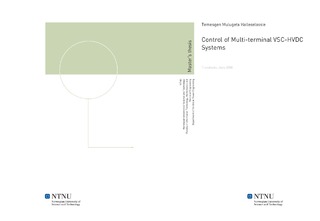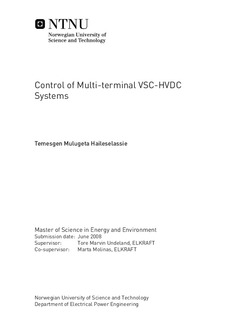| dc.contributor.advisor | Undeland, Tore Marvin | nb_NO |
| dc.contributor.advisor | Molinas, Marta | nb_NO |
| dc.contributor.author | Haileselassie, Temesgen Mulugeta | nb_NO |
| dc.date.accessioned | 2014-12-19T13:50:57Z | |
| dc.date.available | 2014-12-19T13:50:57Z | |
| dc.date.created | 2010-09-03 | nb_NO |
| dc.date.issued | 2008 | nb_NO |
| dc.identifier | 347704 | nb_NO |
| dc.identifier | ntnudaim:4126 | nb_NO |
| dc.identifier.uri | http://hdl.handle.net/11250/256499 | |
| dc.description.abstract | The North Sea has a vast amount of wind energy with largest energy per area densities located about 100-300Km of distance from shore. Should this energy be tapped by offshore wind farms, HVDC transmission would be the more feasible solution at such long subsea distances. On the other hand Norwegian oil/gas platforms in the North Sea use electricity from gas fired turbines at offshore sites. These gas turbines have much less efficiency than onshore generation of electricity and also release large amounts of green house gases. Therefore supplying the platforms with power from onshore transmitted by HVDC will result in benefits both from economic and environmental protection perspectives. Given these two interests for HVDC in the Norwegian offshore, the use of Multiterminal HVDC (MTDC) is a potential solution for the integration of the wind farms and oil/gas platforms into the onshore grid system. Hence, this thesis focuses on the operation and control of MTDC systems. The MTDC system is desired to be capable of interfacing with all kinds of AC grids namely: stiff, weak and passive grid systems. Compared to the classical thyristor based converter, VSC has several features that make it the most suitable converter for making of MTDC, the most decisive being its ability of bidirectional power transfer for fixed voltage polarity. VSC-HVDC is also suitable for implementing control of active and reactive current in synchronously rotating d-q reference frame which in turn results in decoupled control of active and reactive power. In the first two chapters of the thesis literatures are reviewed to understand operation of VSC and its use in HVDC systems. Afterwards controllers are developed for different AC connections (stiff, weak and passive) and for different DC parameter (power, DC voltage) control modes. DC voltage and active power control are implemented by active current control and AC voltage and reactive power control are achieved by reactive power compensation. Tuning techniques for the PI controllers are discussed and used in the simulation models. Finally control techniques for reliable operation of MTDC are developed. In order to validate theoretical arguments, each of the control schemes was developed and simulated in PSCAD/EMTDC simulation software. Simulation results indicate that satisfactory performance of VSC-HVDC was obtained with the proposed active/reactive power controllers, AC/DC voltage controllers, frequency and DC overvoltage controllers. For coordinated multiterminal operation, voltage margin control method and DC voltage droop characteristic were used. These are control methods based upon realization of desired P-UDC characteristic curves of converter terminals. Four-terminal MTDC system with different AC grid connections was used to study the multiterminal operation. Simulations have shown that voltage margin control method results in reliable operation of MTDC during loss of a terminal connection without the need for communication between terminals. The use of DC voltage droop control along with voltage margin control enabled load sharing among VSC-HVDC terminals in DC voltage control mode according to predetermined participation factor. | nb_NO |
| dc.language | eng | nb_NO |
| dc.publisher | Institutt for elkraftteknikk | nb_NO |
| dc.subject | ntnudaim | no_NO |
| dc.subject | MSELPOWER Master of Science in Electric Power Engineering | no_NO |
| dc.subject | Elektrisk Energiteknikk | no_NO |
| dc.title | Control of Multi-terminal VSC-HVDC Systems | nb_NO |
| dc.type | Master thesis | nb_NO |
| dc.source.pagenumber | 118 | nb_NO |
| dc.contributor.department | Norges teknisk-naturvitenskapelige universitet, Fakultet for informasjonsteknologi, matematikk og elektroteknikk, Institutt for elkraftteknikk | nb_NO |

